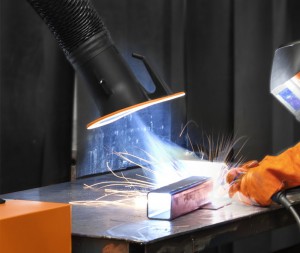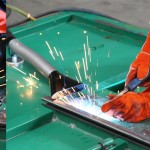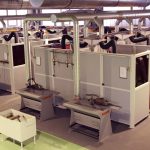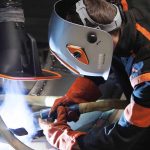Better welding fumes extraction: Rotatable extraction hood with flange brings higher coverage
The quality of an extraction hood is of utmost importance to ensure that welders accept the welding fumes extraction system. Thanks to a special design, the extraction hood with flange requires 40% less repositioning than standard extraction hoods. It is not just the flange that distinguishes it from standard systems.
The extraction hood is the most common component in extraction technology for welding. In companies all over the world, it is the first thing that gets into contact with welding fumes and that despite the fact that it is not force controlled – as we say in professional circles – during the welding process. Actually, local extraction systems are preferable as they force the welder to move the extraction system along during welding processes. Burner integrated systems or extraction systems positioned over the welding shield are, however, a no go for many welders due to the additional weight of the burner and awkward handling. Another disadvantage: Welders cannot extract at any strength without potentially also extracting their inert gas.
Non-force controlled extraction hood has to be designed perfectly
Local extraction with extraction hood, so-called low vacuum extraction systems can, however, already capture larger quantities of welding fumes at the source. Yet, they have a drawback: They are separated from the actual welding process and thus not force controlled. Welders have to track along the extraction arm with extraction hood in order to achieve a high coverage. Funnel-shaped hoods are used in welding companies. Findings, however, show that a flange at the hood is essential for the optimum welding fumes extraction. For welding, however, this is not the only things that matters but the entire quality of the extraction hood is important:
- For extraction hoods without flange, the air from the area behind the suction opening is also drawn in. In this case, power is lost which is then lacking at the front. The radius of the extraction area with flange is thus significantly greater at the front as well as on the sides. This makes it possible for the welder to weld for longer without leaving the effective range of the extraction system. Therefore, they have to readjust the system less.
- The extraction hood should be oblong and adapt with its line shape also to the welding seam. This means that welders have to be able to rotate them to bring them into the direction of the intended welding seam. It has to be possible to rotate it 360 degrees.
- The transition from flange to extraction hood is fitted with relatively large curves so that the air flow can adapt to the shape and thus bundles the welding fumes.
- Stiff extraction arms and hoods are not moved but ignored. It has to be possible to move them single-handedly so that the welder can track them without major interruption to the welding process. An ergonomic grip is helpful, but above all great flexibility of the extraction hood including connected extraction arm is essential. It has to be possible to adjust this freely and yet be self-supporting to keep the set position.
- Further features are useful to make it easier for the welder to do his work when working with an extraction hood for local extraction. A LED light integrated in the extraction hood improves e.g. the view of the workpiece and also makes the welder track the extraction hood along the welding seam for this reason alone.
 A scientific test series supports these findings. It says that funnel-shaped extraction hoods are not ideal to capture welding fumes efficiently and also save energy during plant operation. The Institut für Gefahrstoff-Forschung (Institute for Hazardous Materials Research) attached to Ruhr-University Bochum set up the test series for a test rig. Their result: Using the same conditions for all extraction hoods, extraction hoods with flange scored best in capturing welding fumes as efficiently as possible during scientific research. The special extraction hood prevented solely prevented the suction of non-contaminated “false air“ simply thanks to its design. In addition, according to the study, a greater distance to the source of the welding fumes is possible to capture the same quantity of welding fumes in comparison to conventional systems in the same conditions.
A scientific test series supports these findings. It says that funnel-shaped extraction hoods are not ideal to capture welding fumes efficiently and also save energy during plant operation. The Institut für Gefahrstoff-Forschung (Institute for Hazardous Materials Research) attached to Ruhr-University Bochum set up the test series for a test rig. Their result: Using the same conditions for all extraction hoods, extraction hoods with flange scored best in capturing welding fumes as efficiently as possible during scientific research. The special extraction hood prevented solely prevented the suction of non-contaminated “false air“ simply thanks to its design. In addition, according to the study, a greater distance to the source of the welding fumes is possible to capture the same quantity of welding fumes in comparison to conventional systems in the same conditions.
40 percent less tracking for extraction hood with flange
In figures, this means: An extraction hood with a 50 mm wide flange captures on all four sides around 10 per cent more welding fumes than a funnel-shaped extraction hood – which means 40 percent overall. Following on from this: Less air flow is needed for equipment operation and thus less energy is required for plant operation in order to extract the same amount of welding fumes in the same conditions.
The study assumes that welding processes such as MAG-welding create large quantities of welding fumes, which conventional solutions of extraction hoods without flange cannot capture sufficiently. The study thus recommends extraction hoods with flange on this basis.






